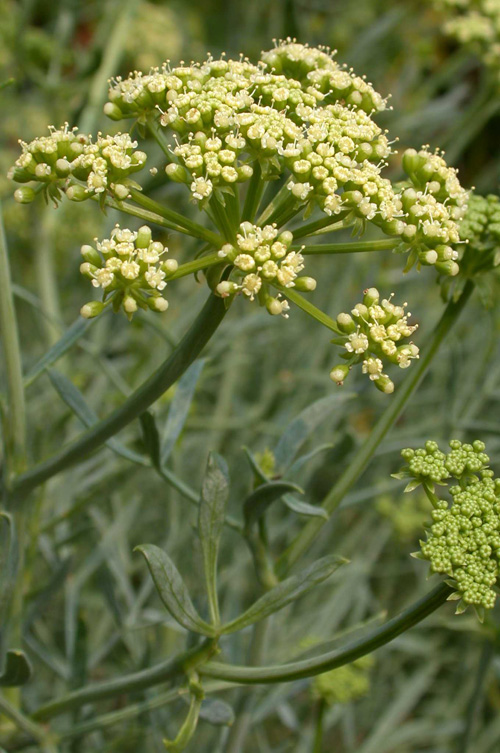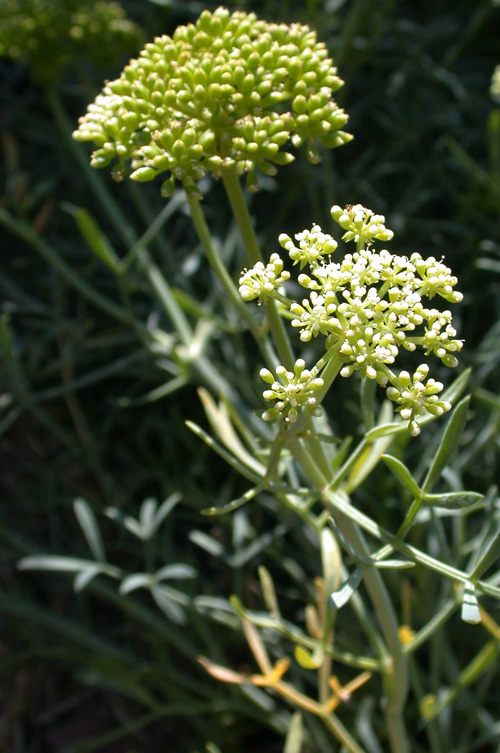Crithmon, some call it Critamon, is a little shrubbie herbe, thick of leaves, the height of it is about a cubit, growing in rockie and maritime places, being full of fatt, and whitish leaves, like unto those of Purcelane, yet thicker & longer & salt to ye tast.
???Dioscorides, De Materia Medica, Book II: 157
Rock samphire is one of several maritime species grown in Bonnefont herb garden. This edible plant was foraged rather than cultivated in the Middle Ages; it also had medicinal uses. Below, left to right: Samphire in bloom; the flower structure is typical of the Apiaceae, a large family of??aromatic plants. Ripening seedheads; the name “crithmon” by which the plant was known in antiquity is thought to derive from the Greek word for barley, as the seeds resemble the grain.
A maritime plant with a history of culinary and medicinal use that extends from Greek antiquity to the present day, rock samphire (Crithmum maritimum) is native to sea cliffs and shingle beaches on the Mediterranean and the Atlantic coast of Europe, as well as the Black Sea. The common English name derives from the French sampi??r, which is a corruption of herbe de Saint Pierre; the plant was named after the fisherman apostle, whose own name was derived from the Greek petra, or rock. This association is??preserved in a number of European languages. A list of common names is available on the website Gardening in Mediterranean Climates Worldwide.
Dioscorides notes that the seed, root, and leaves seethed in wine were helpful for those suffering from afflictions of the urinary tract, or from jaundice.????According to Pliny, it??is also good for the spleen and beneficial to the complexion.?? (Crithmum maritimum is now used in a number of cosmetic preparations.)??The fifteenth-century herbal Der Gart der Gesundheit classes??samphire as warm and dry in the second degree, and recommends it as a diuretic useful in treating dropsy, an old term for edema. (For more on the classification of medicinal herbs according to their qualities, see “Cool, Cooler, Coolest,” July 27, 2012). Although samphire’s curative properties were recognized, it was more important as a foodstuff than a medicament. Dioscorides mentions that it was eaten both raw and cooked, and was also preserved in brine; Pliny says it was sometimes boiled with cabbage.
Pier Andrea Mattioli, the great sixteenth-century commentator on Dioscorides, noted that rock samphire grew plentifully on the coast of Italy, and John Gerard reported it as flourishing on the cliffs of Dover and in the vicinity of Southampton, Winchelsea, Rye, and the Isle of Wight, as well as many rocky places in the west and northwest of England. For Gerard’s account of “Rock Sampier,” see Book II, Chap. 144 of the 1597 edition of The Herball or Generall Historie of Plantes. (Gerard’s discussion of samphire is followed by a chapter on another maritime plant, Salicornia europea, or glasswort. Although botanically unrelated, it is sometimes called “marsh samphire,” as it is gathered, prepared and eaten in much the same way that Crithmum maritimum is; since the plants share the same habitat, they are often confused. Unlike rock samphire, the only member of its genus, Salicornia species can be found growing in North America.)
The perils of gathering rock samphire were well advertised in the Renaissance, most famously by Shakespeare, in Act 4, Scene 6 of King Lear.?? Shakespeare has Edgar deceive his blind father, Gloucester, and thwart the latter’s plan to kill himself by leaping into the sea. He leads his deluded parent over level ground while pretending to climb the cliffs of Dover, inventing a vertiginous view from a height:
Edg. Come on, sir; here’s the place: stand still.
How fearful
And dizzy ’tis to cast one’s eyes so low!
The crows and choughs that wing the midway air
Show scarce so gross as beetles; half way down
Hangs one that gathers samphire, dreadful trade!
Methinks he seems no bigger than his head.
Although restricted to rocky habitats moistened by salt spray, rock samphire seems to have been relatively abundant until recent times. Coastal development and over-foraging have reduced the wild populations. It has been a protected plant in Great Britain since 1971, and is listed as endangered in other parts of Europe, such as the Balearic Islands. (See the website Plantarum maioricarum.)
Crithmum is sometimes grown in gardens, but the cultivated variety lacks the pronounced saltiness characteristic of the wild plant. When bruised or broken, the leaves smell strongly but pleasantly of lemon oil and are more suggestive of a furniture polish than a foodstuff. The raw leaves have a strong carroty taste. (These two aromatic species belong to the same botanical family.) Samphire is best when poached as a vegetable, pureed with butter as a sauce, or pickled. Many historical recipes as well as recipes for modern kitchens can be found online, although Americans who want to cook rock samphire may have to grow their own. For a basic recipe for pickled rock samphire see the website Eat Weeds.
We have grown samphire for many years at The Cloisters with some success, but transplanted it last spring to a very sunny, sheltered spot under the parapet wall in Bonnefont cloister, one of the warmest and driest places in the garden, and it seems to prefer this site. We have not (yet) spritzed it with sea water, and the leaves don’t seem as thick as in photographs of wild plants. For images of Crithmum maritimum growing in its native habitats, see G??nther’s Site, an extraordinary and meticulously organized photographic collection of European species.
Kay Sanecki, a British authority on herbs and herb growing, and the author of many books on the subject, recommended that “barilla” be added to the soil in which rock samphire was cultivated. I’d never encountered a mention of this emendment, which proved to be a soda ash made from salt-tolerant plants like the Salicornia europeaea mentioned above. See wikipedia for more on barilla, which was of considerable economic importance from the Middle Ages onward, because of its use in glass-making.
???Deirdre Larkin
Sources:
Anderson, Frank J., ed. “Herbals through 1500,” The Illustrated Bartsch, Vol. 90. New York: Abaris, 1984.
Davidson, Alan. The Oxford Companion to Food. Oxford: Oxford University Press, 1999.
Gunther, Robert T., ed. The Greek Herbal of Dioscorides, translated by John Goodyer 1655. 1934. Reprint: New York: Hafner Publishing, 1968.
Pliny. Natural History, Vol. VII, Books XXIV???XXVII. Translated by W. H. S. Jones. Cambridge, MA: Loeb Classical Library, 1956, reprinted 1966, revised 1980.
Sanecki, Kay N. The Complete Book of Herbs. New York: MacMillan, 1974.
Stannard, Jerry. “Dioscorides and Renaissance Materia Medica” (IX, 1???21) in Herbs and Herbalism in the Middle Ages and Renaissance. Eds. Katherine Stannard and Richard Kay. Brookfield, VT: Ashgate, 1999.
Tags: Apiaceae, Crithmum maritimum, Dioscorides, glasswort, John Gerard, King Lear, Pliny the Elder, rock samphire, Salicornia europea, sampier


